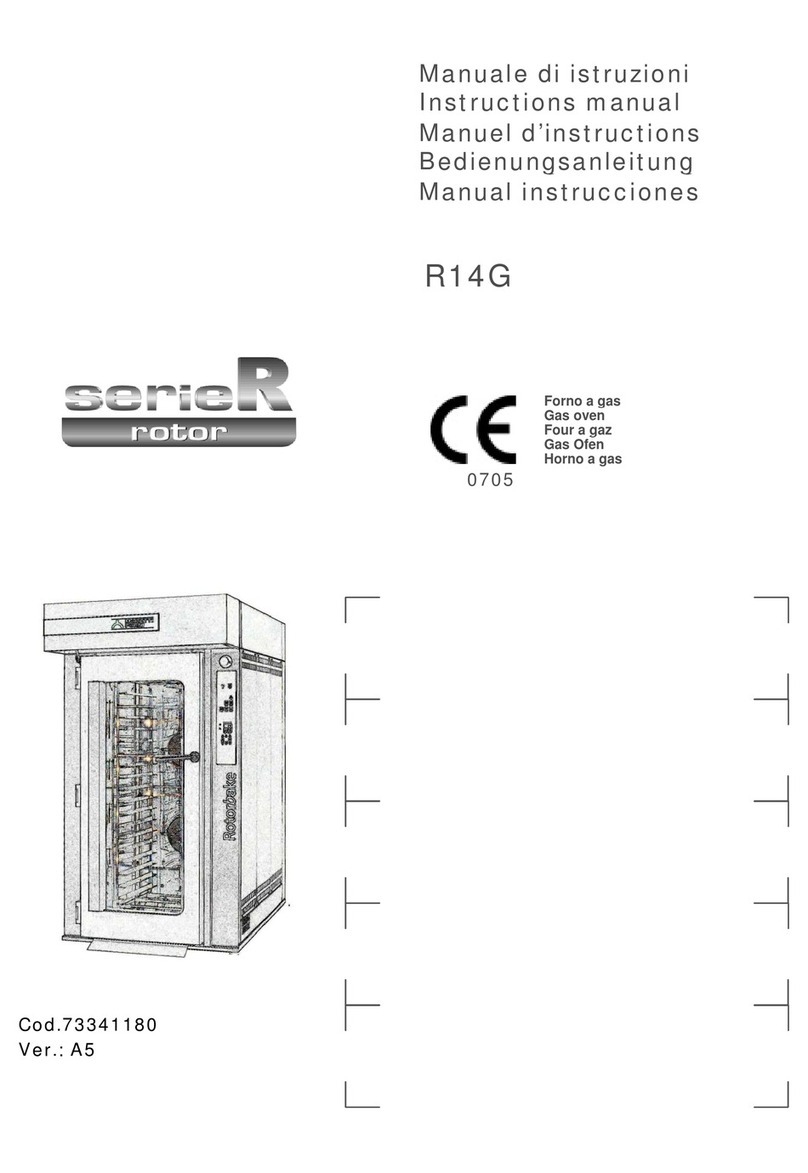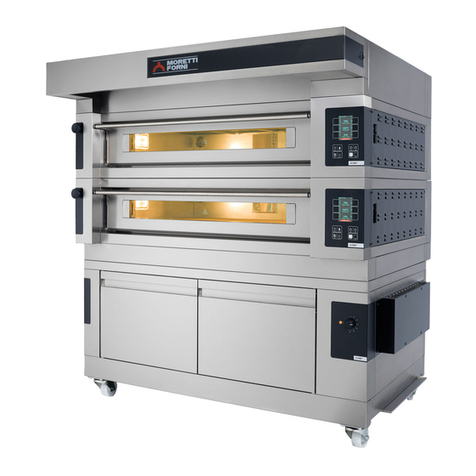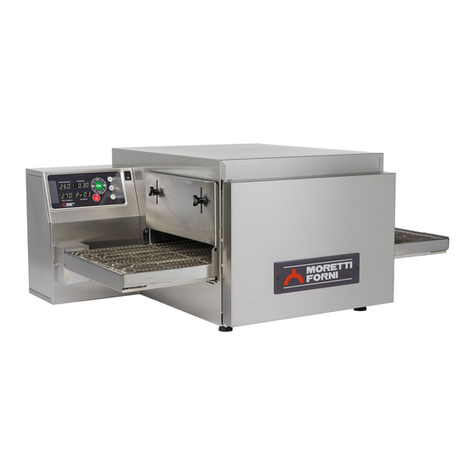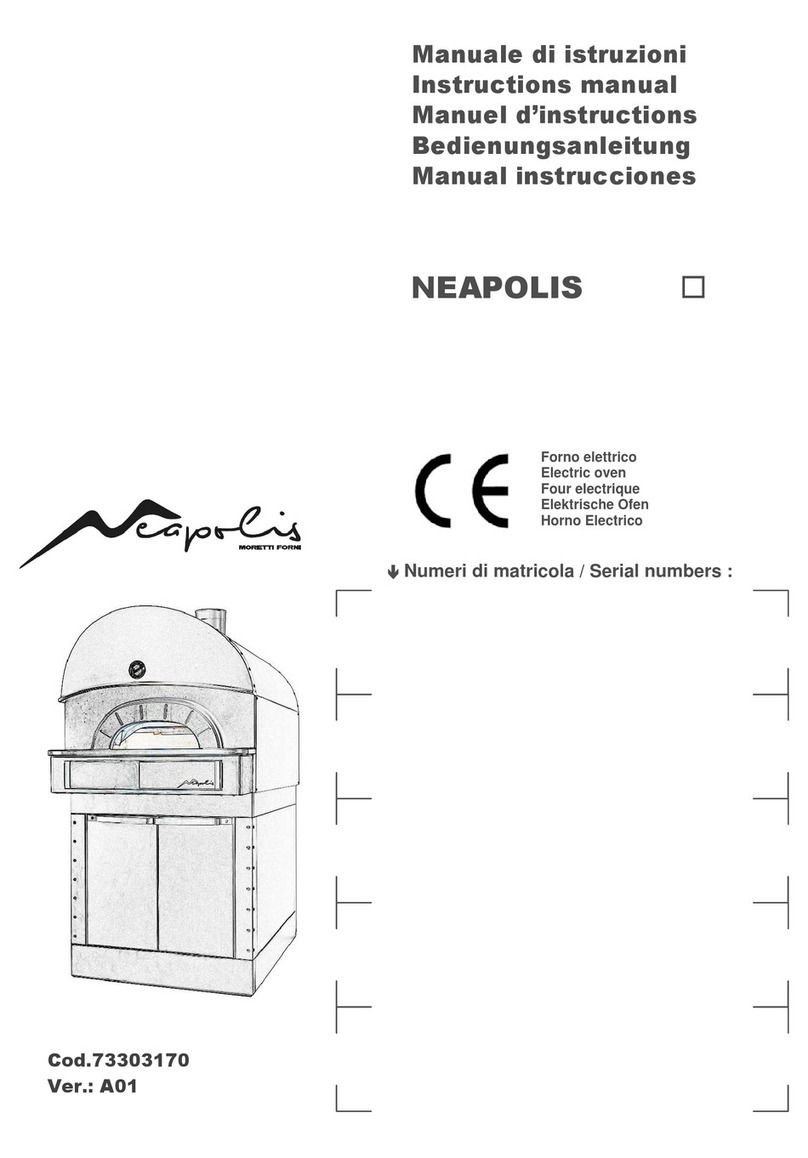
IT/
T75E T97E: il forno è dotato di due termocoppie, una Superiore ed una Inferiore.
Togliere il portello sinistro superiore o inferiore (fig.18 part.A-W) svitando le viti di
fissaggio, per accedere alla termocoppia superiore o inferiore.
- Svitare il dado di fissaggio della termocoppia (fig.19 part.E).
- Scollegare i due cavi di alimentazione della termocoppia.
- Sostituire la termocoppia.
- Eseguire le operazioni inverse per il rimontaggio, prestando attenzione di collegare
i connettori secondo le giuste polarità.
- Per rimontare il nastro trasportatore seguire la procedura al punto 5.2.2.
T64E-TT98E: il T64E è dotato di due termocoppie (Superiore, Inferiore), il TT98E
di quattro termocoppie (Superiore, Inferiore Sinistra, Destra).
NOTA: Per qualsiasi motivo si debba rimuovere o spostare una
termocoppia, al fine della sua integrità, È TASSATIVO MOVIMENTARLA
PRENDENDOLA ESCLUSIVAMENTE SUL TUBETTO METALLICO E
MAI SUL CAVO.
-Aprire pannello porta componenti seguendo la procedura al punto 5.3.1
- Togliere il portello corrispondente (solo TT98E) (fig.36 part.A-B-H-I)
- Togliere la soffiante corrispondente seguendo la procedura al punto 5.2.1.
- Svitare la vite di fissaggio della termocoppia con chiave a brugola (fig.37 part.V).
- Per sfilare i cavi delle termocoppie sul lato destro (solo TT98E) è necessario
smontare i pannelli posteriore (fig.38 part. T-S)
- Scollegare il cavo dalla scheda elettronica e sfilare la termocoppia.
- Sostituire la termocoppia prestando attenzione di collegare i connettori secondo
le giuste polarità.
NOTA: Assicurarsi che l’estremità di ogni termocoppia sia sempre
posizionata sul taglio inclinato del tubo come riportato in fig 37 part W
- Rimontare la soffiante corrispondente seguendo la procedura al punto 5.2.2.
- Eseguire le operazioni inverse per il rimontaggio.
- Chiudere pannello porta componenti seguendo la procedura al punto 5.3.3.
- Per rimontare il nastro trasportatore seguire la procedura al punto 5.2.2.
5.6 SOSTITUZIONE DELLE RESISTENZE
Eseguite le operazioni al punto 5.1, per la sostituzione delle resistenze procedere
come segue:
T75E-T97E-TT98E
- Per le resistenze superiori togliere le paratie laterali regolabili destra e sinistra
(fig.10 part.I) svitando i pomelli (fig.10 part.L).
- Per le resistenze inferiori togliere il nastro trasportatore seguendo la procedura al
punto 5.2.1.
T75E T97E: Togliere i portelli superiori o inferiori (fig.18 part.A-B-W-Z) svitando
le viti di fissaggio, per accedere alle relative resistenze.
- Scollegare da entrambi i lati i fili d’alimentazione delle resistenze;
- Togliere da entrambi i lati la coibentazione cercando di non rovinarla.
- Dal lato sinistro con una chiave a tubo togliere il dado (fig.19 part.F) sulla
resistenza che si desidera cambiare.
- Dal lato destro con un cacciavite togliere le viti (fig.20 part.G),sfilare la piastra
porta resistenza e da questo lato sfilare la resistenza.
- Eseguire le operazioni inverse per il rimontaggio delle nuove, ripristinare la parte
di coibentazione eventualmente danneggiata prestando attenzione che non arrivi ai
contatti elettrici.
TT98E:
Resistenze inferiori o superiori sinistre TT98E
-Aprire il pannello porta interruttori seguendo la procedura al punto 5.3.1
- Togliere il carter protezione componenti elettrici (fig.36 part N)
- Togliere i portelli superiori o inferiori (fig.36 part.H-I-L-M)
- Scollegare i cavi elettrici
- Rimuovere i carter protezione coibentazione resistenze (fig.37 part.Q-R)
- Spostare la coibentazione cercando di non rovinarla.
- Svitare le viti di fissaggio piastrino resistenze.
- Sostituire la resistenza danneggiata
- Eseguire le operazioni inverse per il rimontaggio.
- Chiudere il pannello porta componenti elettrici seguendo la procedura al punto
5.3.3.
Resistenze inferiori o superiori destre TT98E
- Aprire il pannello laterale svitando le 2 viti di fissaggio (fig.16 part L)
- Sfilare la copertura giunto nastro(fig.16 part.U) svitando la vite che la blocca
(fig.16 part.X).
- Sollevare il nastro trasportatore dal lato motore di alcuni centimetri e sfilare il
giunto nastro (fig.16 part.Z).
- Rimuovere il carter inferiore sul giunto nastro (fig.36 part F)
- Togliere il carter protezione motore nastro (fig.36 part E)
- Togliere i portelli superiori o inferiori (fig.36 part.A-B-C-D)
- Scollegare i cavi elettrici
- Rimuovere i carter protezione coibentazione resistenze (fig.37 part.O-P)
- Spostare la coibentazione cercando di non rovinarla.
- Svitare le viti di fissaggio piastrino resistenze.
- Sostituire la resistenza danneggiata.
- Eseguire le operazioni inverse per il rimontaggio.
– Richiudere il pannello laterale ed avvitare le 2 viti di fissaggio (fig.16 part L)
NOTA: Assicurarsi che all’interno del forno TT98E la parte finale
delle resistenze sostituite entrino nella loro sede, vedere la corrispondente
posizione dall’interno della camera di cottura smontando i componenti
come da procedura al punto 5.2.1, per il rimontaggio seguire la procedura al
punto 5.2.2.
T64E
-Togliere il pannello posteriore svitando le viti di fissaggio.
-Scollegare il motore ed i faston del sensore termico
-Individuare il gruppo di resistenze da sostituire tenendo presente che i
terminali lato quadro elettrico sono relativi alle resistenze del cielo, quelli
opposti sono relativi alle resistenze della platea.
-Scollegare i terminali delle resistenze utilizzando una seconda chiave sul
controdado come antirotazione per evitare la forzatura del terminale.
NOTA: Eventuali forzature dei terminali delle resistenze in fase di
collegamento/scollegamento dei cavi elettrici compromettono
irrimediabilmente tutto il gruppo di resistenze!
-Togliere i pannelli di contenimento lana
- Rimuovere il pannello posteriore camera di cottura svitando le viti di fissaggio.
- Portarsi su di un piano di lavoro.
- Sostituire la resistenza danneggiata.
- Eseguire le operazioni inverse per il rimontaggio.
5.7 SOSTITUZIONE DEL DISPLAY TFT
Eseguite le operazioni al punto 5.1, per la sostituzione del Display TFT o quadro
comandi procedere come segue:
- Smontare la staffa (fig.35 part. A)
- Montare lo schermo calore (fig.35 part. B)
- Svitare le viti di fissaggio quadro comandi (fig.21 part.H).
- Scollegare i connettori del Display.
- Sostituire il quadro comandi
- Togliere i 3 dadi (fig.21 part.I) e sostituire il Display.
- Eseguire le operazioni inverse per il rimontaggio, prestando attenzione di
collegare i connettori correttamente.
NOTA:Eseguire la procedura di “Default di fabbrica” della centralina
come da punto 5.19.
5.8 SOSTITUZIONE DELLA TASTIERA QUADRO COMANDI
I tasti del quadro comandi sono incorporati nella scheda Display. Per la
sostituzione della scheda Display eseguire le operazioni al punto 5.6.
5.9 SMONTAGGIO E MONTAGGIO NASTRO
Eseguite le operazioni al punto 5.1, per lo smontaggio ed il montaggio del nastro
procedere come segue:
- Sfilare il nastro trasportatore dalla camera di cottura eseguendo le operazioni
indicate nel punto 5.2.1, porlo su di un piano di lavoro dotati di una pinza a
becchi lunghi.
5.9.1 SMONTAGGIO NASTRO
- Eseguite le operazioni al punto 5.1, per lo smontaggio del nastro procedere
come segue:
- Fare scorrere il nastro fino a che la giunzione arrivi nella parte superiore
centrale.
- Comprimere il nastro dal lato destro (fig.22).
- Solo per T75E T97E: con la pinza fare scorrere lateralmente sulle maglie i
quattro tubetti di giunzione (fig.23).
- Sganciare le maglie di giunzione con l’ausilio di pinza.
- Togliere la compressione all’estremità del nastro.
- Sfilare il nastro
5.9.2 MONTAGGIO NASTRO
-Eseguite le operazioni al punto 5.1, per il montaggio del nastro procedere come
segue:
- Infilare il nastro dal verso voluto, prestando attenzione che la parte superiore
rimanga liscia e che le estremità laterali a forma di gancio non vadano mai dal
verso in cui tendono ad agganciarsi (fig.27).
- Avvicinare le estremità del nastro nella parte superiore centrale verificando
attentamente che le ruote dentate all’estremità sinistra e le boccole di rinvio
all’estremità destra aggancino il nastro in maniera corretta.
NOTA: solo per T75E e T97E: Le boccole di rinvio non devono mai
essere in corrispondenza dei tubetti di giunzione,le due ruote all’estremità
devono essere rivolte come nell’esploso Tav.A.
- Comprimere il nastro dal lato destro (fig.22).
T75E T97E: Prendere una delle maglie di giunta laterali e dopo avere osservato
come sono montate le estremità del nastro (fig.24a) agganciare prima la parte
laterale esterna e poi quella interna eventualmente aiutandosi con la pinza a
becchi lunghi.
- Ripetere l’operazione per la maglia del lato opposto.
- Agganciare i pezzi intermedi (fig.25), e con l’ausilio della pinza raddrizzare le
maglie che si fossero deformate.
- Inserire i tubetti nelle maglie, posizionarli al centro della giunzione e
schiacciarli alle due estremità (fig.26), verificando che non scorrano.
































